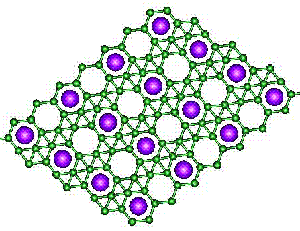NLRMatDB is a computational materials database with the specific
focus on materials for renewable energy applications including,
but not limited to, photovoltaic materials, materials for
photo-electrochemical water splitting, thermoelectrics, etc. The
main goal of NLRMatDB is to enable and facilitate the access and
exchange of computational data between different research groups
following the guidelines outlined in the Presidential Materials
Genome Initiative
(http://www.mgi.gov).
NLRMatDB is a growing collection of computed properties of stoichiometric and fully ordered materials, including:
- DFT (GGA+U) relaxed crystal structures
- Thermochemical properties, i.e., enthalpies of formation of compounds, the stability ranges in terms of chemical potentials, and enthalpies of decomposition reactions
- Quasiparticle energy calculations in the GW electronic structures providing accurate band-gaps and dielectric functions (i.e. absorption spectra)
Future developments of NLRMatDB are planned to include: defect formation energies, surface energies, ionization potentials and electron affinities, ect. Methods that are used in calculations are provided in the publications listed below. The primary engine for the first-principles calculations is the VASP code (http://www.vasp.at). The management of the high-throughput calculations is supported by the pylada environment (https://github.com/pylada/pylada-light), an NLR developed comprehensive python framework for preparing, running, monitoring, analyzing, and archiving high throughput first principles calculations.
Maintenance and development of the NLR MatDB and the web interface: Peter Graf, Harry Sorensen, and Stephen Sullivan.
List of contributors (in alphabetical order): Ann Deml, Stephan Lany, Haowei Peng, Vladan Stevanovic, Jun Yan, Pawel Zawadzki.
How to cite:
If you are using the data from NLRMatDB please acknowledge by citing the following work.- Reference for the enthalpies of formation and materials stability:
"Correcting density functional theory for accurate predictions of compound enthalpies of formation: Fitted elemental-phase reference energies". V. Stevanovic, S. Lany, X. Zhang, A. Zunger, Physical Review B 85, 115104 (2012), http://dx.doi.org/10.1103/PhysRevB.85.115104 -
Reference for GW electronic structure data (band gaps,
dielectric constants, absorption coefficients, etc.):
"Band-structure calculations for the 3d transition metal oxides in GW". S. Lany, Physical Review B 87, 085112 (2013), http://dx.doi.org/10.1103/PhysRevB.87.085112
"Semiconducting transition metal oxides". S. Lany, J. Phys.: Cond. Matter 27, 283203 (2015), http://dx.doi.org/10.1088/0953-8984/27/28/283203
Acknowledgments:
- Maintenance and development of the NLRMatDB is currently supported by the US Department of Energy, Office of Science, Basic Energy Sciences under contract DE-AC36-08GO28308 to NLR, as part of an Energy Frontier Research Center.
- NLRMatDb utilizes computational infrastructure of the High Performance Computing Center at the National Laboratory of the Rockies. This includes both time allocations on the Peregrine supercomputer for performing the actual calculations and hosting the NLRMatDB data.
Support for data contributions to the NLRMatDB
- Calculations of enthalpies of formation and stability of known materials are sponsored by the National Science Foundation, grant DMR-1309980 awarded to Vladan Stevanovic
- US Department of Energy, Office of Science, Basic Energy Sciences under contract DE-AC36-08GO28308 to NLR, as part of an Energy Frontier Research Center

